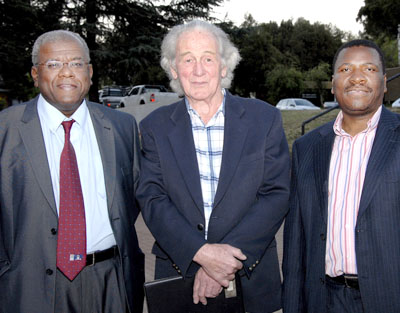 |
|
At the Beyers Naudé Memorial lecture were, from the left: Prof. Jonathan Jansen, Rector and Vice-Chancellor of the UFS; Rev. Cedric Mayson; and Mr Kgotso Schoeman, Chief Executive Officer of Kagiso Trust.
Photo: Dries Myburg
|
The seventh Beyers Naudé Memorial lecture was presented for the first time at the University of the Free State (UFS) this week. This lecture that is presented at a different university each year took place on the Main Campus of the UFS in Bloemfontein this year. Rev. Cedrick Mayson presented the lecture with under the theme: Crafting a legacy.
According to Rev. Mayson more deeply rooted forms of suppression came forward after the democratic elections in 1994. Liberation from apartheid was, according to Mason, very superficial. The poor were still severely suppressed at economic, political, cultural, religious and environmental level. “We have to apply Beyers Naudé’s legacy of liberation in these areas,” Rev. Mayson declared.
“The system according to which the rich become wealthier and the poor become poorer must be replaced by a system where everybody can have enough. This is only possible with the insight of the oppressed.
“The government and the opposition are dominated by people who seek advantage for their own gain. Regardless of democratic slogans and some enlightened individuals’ rules against corruption and violence, we lack the political will to engage in the transformation of the whole world for the good of all earthlings,” said Rev. Mayson.
According to him, consumer culture has become a fine-tuned instrument for keeping people incomplete, shallow and dehumanised.
“Religions are self-centred. Leaders from most of the religious groupings criticised apartheid but they never joined the struggle to assist in demolishing apartheid. It appears as if religious institutions are not able to address the causes of poverty because they themselves are too rich and too powerful,” said Rev. Mayson.
He ended with the following words: “What we need is a leap of faith. Beyers knew that. The world is waiting for people to claim their legacy and to accomplish a post-religious secular spirituality of ubuntu.”
Rev. Mayson is a former Head of Religious Affairs of the ANC. He had also been a former staff member of the Christian Institute before it was banned. Furthermore, he was the Editor of Pro Veritate. Before he retired, he had also been involved in the South African Council of Churches and the World Conference for Peace.
The memorial lecture, a collaborative effort of the UFS and Kagiso Trust, endeavours to involve South Africans in dialogue about issues that affect our nation. This year the lecture was presented at the UFS for the first time and it will take place on the Qwaqwa Campus of the UFS next year.
Media Release
Issued by: Mangaliso Radebe
Assistant Director: Media Liaison
Tel: 051 401 2828
Cell: 078 460 3320
E-mail: radebemt@ufs.ac.za
16 September 2010